It is said that half of newly birthed restaurants do not celebrate their second birthday. I question the basis for this somber and dispiriting statistic. Perhaps it is proclaimed by chefs who wish to raise the drawbridge after they cross. This is one of the army of factoids too good to be false.
Despite my doubts as to the certainty of the evaporating restaurant, it recognizes a partial reality. If diamonds are forever, beaneries are not. And yet every young chef believes that s/he will be the exception. So we find Ureña, the newly opened redoubt of Chef/Owner Alex Ureña, formerly chef at Suba, Marseilles, and, for a glittering moment with Dan Barber at Blue Hill. Ureña is formerly of River Café, Jo Jo, Bouley, La Caravelle, La Côte Basque, and El Bulli. Can't this man keep a job?
It takes the labor of mundane repetition to learn from masters. Can one soak up enough as a culinary tourist? Except for his lengthy, early training in Bouley (Alex Ureña started working in restaurants shortly after he landed in New York from the Dominican Republic at age fifteen), Ureña is a gastronomic butterfly. He has worked many years, but he is still a young cook. Too green to be an owner if baseball were his sport. Even callow W was grayer.
Ureña has been exposed to much and has talent in abundance, but as yet he lacks capital and a distinctive culinary vision. Adding Spanish ingredients, though wise, does not a cuisine make. Ureña's space is, as has been noted, one of the least impressive rooms for a restaurant of its ambition. With the exception of impressive toilets, everything is done on the cheap. A devout aesthete might chose to eat on the pot. The tables are laid out to insure that a service will be an obstacle course. On this nearly deserted midweek night the close quarters represent a triumph of hope over experience.
Ureña's servers are still learning their craft. We were served flat water in place of sparkling, our server didn't know whether the panko bread crumbs were wheat-based, some dishes were poorly described, and we weren't offered coffee at the proper moment. The service was cheerful, but training remains: perhaps established servers perceive that Ureña is not here for the long haul. No doubt with time - if time there is - this will be sorted out.
Ureña's cuisine had both real successes, a few errors, and many satisfying attempts. With a $100 nine course chef's tasting menu, this is a few steps below elite dining, but the price suggests a seriousness of purpose. The style is Manhattan Moderne by means of Barcelona: a blending of Blue Hill and Bouley, with perhaps a bit of El Bulli as seasoning, although the Iberian influence is most noticeable in the occasional choice of ingredients: chorizo, chicharon, manchego, and saffron. Despite suggestions that Ureña is an outpost of molecular cuisine (New York magazine suggests it is "the kind of place that assumes a certain foodie familiarity with phrases like mustard paper and chorizo emulsion"), the restaurant doesn't provoke or bewilder. This is no WD-51. Were Alex Ureña an Impressionist, he would be a Sisley, not a Monet, a synthesizer. Ureña still a young man's restaurant, short on a unique culinary style. Perhaps he has been over-exposed. Too much is buzzing in his brain - a result none of the many satisfying dishes seemed like a signature dish.
Chef Ureña might have been better advised to open a little place in Williamsburg where he could sharpen his ideas of cuisine. (If only I was his down-market investor!). Away from the Manhattan hothouse would provide time and space and resources to develop an identity and a following, and to experience joy in the process. Ureña is a two star restaurant in a two-bit space. There is much more to achieve.
We ordered the chef's tasting menu (nine courses, plus amuses), and the chef attempted to dazzle us: for most courses the table was served two different preparations that demanded sharing. I hoped we might remain friends through the meal. Eventually some fifteen dishes were served. I appreciated this bounty, but I couldn't help feeling as I espied empty tables that for the kitchen it was us or ennui.
The meal with pair of amusi: Creamy Potato-Fennel Soup and Mussels Escabiche with Pickled Onion. Both were sterling and better by being served together. The soup, so smooth and sumptuous, needed the jolt from the bivalve ceviche. I loved the pungent pickled onion and basil reduction underlying the mussels, making this one of the best and most assured bites of the night. The opening packed a one-two punch.
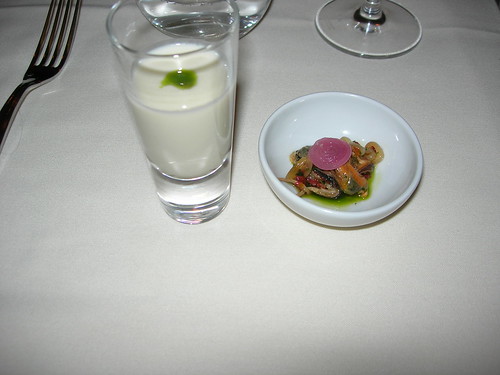
This duo was followed by two appetizers. First, a luscious Ostra Escabeche of Marinated oysters, saimfaina brunoise (a vegetable mix, akin to ratatouille), and smoked oyster gelee foam. In such a mix with oysters the foam brought out and stood apart from the oyster's texture, and the vegetables added a tartness that mixed well with the slightly briny oysters. This was certainly one of the finest raw oyster combinations that I have had, comparable only to the starter at Aquavit.
The Salt Cod Mousse (Baccalao) with flake cod salad, and microgreens with grapefruit, was less compelling. The combination of salt and sour proved intriguing - a potentially clever dish - but less satisfying than its mate with a texture that demanded more crunch.
Our house smoked tuna was a breather. I was impressed by its straight-forward luxuriousness with its onions and greens. If it was not novelty on a plate, it was a subtle take on gravlox. The dish was both a picturesque and harmonious. Not every dish needs to strain at the edge of the envelope of flavor.
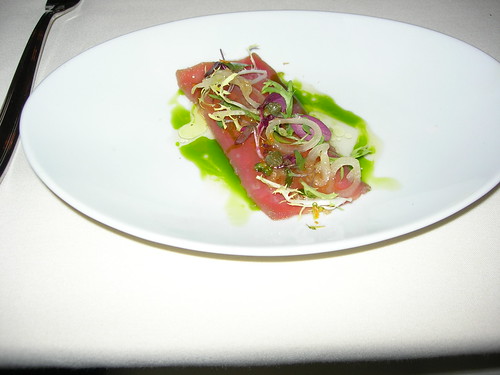
The next pair was warm seafood. Shrimp over Manchego Rice (rice with Spanish sheep's milk cheese)is Spanish for Shrimp on Cheese Grits. Although not wild, it was a startling and effective mixture, mild and robust, and we loved it.
Its partner was Nantucket Sea Scallop with Parsnip Purée and Chorizo Sauce. Chef Ureña presented yet another shotgun marriage of trough and brine. The chorizo sauce should have had more of a smack, and its diffidence emphasized the blandness of the purée. The scallop was well cooked, but was not backed by a strong flavor combination. It was pleasant as a quiet companion to the shrimp.
Two fish dishes followed. I admired the marinated and sauteed mahi mahi with a ginger aromatic sauce over spinach with a portobello confit. This was a delicate and subtle dish, only marred by a slight saltiness. The ginger aromatic was compelling and framed the beefy mahi mahi.
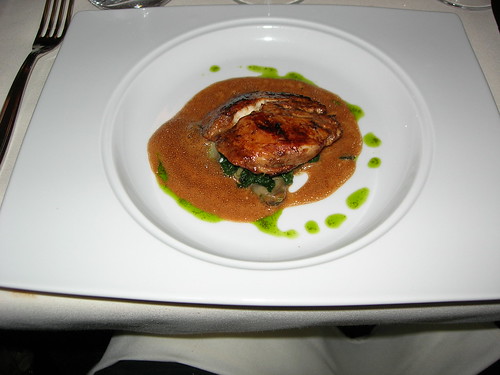
The roasted flounder with glazed celery root, honshemiji mushrooms, manchego and arugula mousse with a grapefruit and elder flower sauce was too busy. Even reading the ingredients is exhausting. On small plates simplicity is often essential. On a larger canvas this construction might allow for a quieter appreciation of ingredients, but here the dish was riotous.
Our fifth course continued the chef's emphasis on seafood, but, in contrast to some earlier efforts, these were undistinguished. The steamed lobster with pickled rhubarb purée, glazed salisfy, and blood orange sauce might have been a high point of the meal. Instead, it was upended by an sickly sweet sauce of goopy consistency. I recognized sweet-and-sour chicken from a small town Chinese take-out. What a waste of a blood orange. What a waste of a lobster.
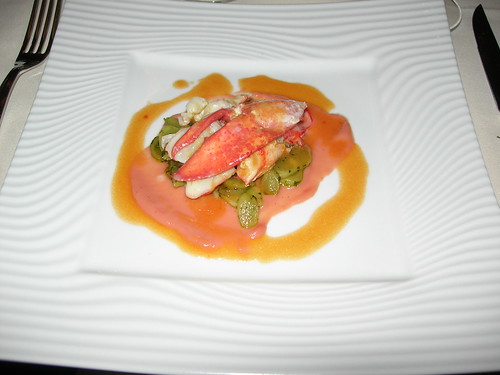
The chicharon (pork rind) crusted halibut with Japanese panko bread crumbs, yellow candied beets, onion soubise, zucchini, and saffron mussel sauce was also a bungle. The flavors were muddied. The fish was fine, but the tastes, as served, lacked distinctive definition. Again, the problem may have been this chef needs a larger canvas than what a tasting menu can provide.
Finally we reached our meat course. I thought that the seared duck breast with Savoy cabbage, bacon, dried apricots, and star anise scented sauce was one of the finest plates of the night. Chef Ureña was confidently playing with duck cliches. The duck itself was seared and intense, and the star anise sauce brought a striking bitter-sweetness to the breast. The dried apricots and cabbage proved an inspired match (perhaps add chanterelles), and the complexity of the dish didn't mash together. Many of the plates, but particularly this, had a Blue Hill aspect, closer than to the games of molecularism.
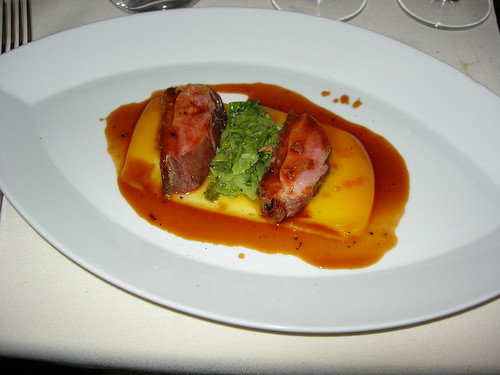
I enjoyed the roasted lamb chop with cashew nut purée, Swiss chard, and oyster mushrooms. Although the idea of a cashew nut purée was an intriguing conceit, it didn't add much to the lamb but was intriguing by itsef. Ultimately this dish stood successfully on the quality of the well-cooked chop.
The pastry chef at Ureña is Caryn Stabinsky, formerly at WD-50. Because of the allergies of a tablemate, we were not served her signature dessert, "breakfast" (desayuno) - wheat toast cake, Bulgarian feta, maple caramel, with rosemary ice cream, but it seemed more intriguing than the three choices provided.
Our first dessert was an oddity: dill yogurt sorbet with Meyer lemon curd and sea salt. The dill yogurt was unexpected. Curious if not quite compelling. Chef Stabinsky was indulging herself at our expense.
Second was almond ice cream over candied almonds with piccolo (?) pepper sauce. The almond ice cream over almonds was almost dessert-normal, fully admirable, but to gain our attention pepper sauce was dribbled around. I didn't find that it added much other than an demand that a diner pay attention to the musing of a chef.
The final dessert was beet panna cotta, chocolate sauce, broken chocolate cookie with orange salt (salt again!), and sour cream ice cream. The beet panna cotta was a treat - pungent, mild and sweet in a bite. The rest of the plate, deconstructed as it was, held nothing so much as a bit of this and that. The beet panna cotta was a special crimson delight, richly made and happily consumed.
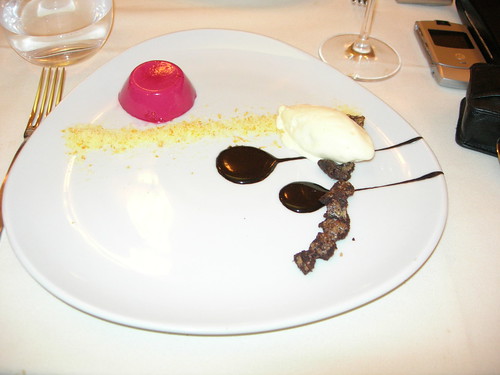
Our dinner contained many gratifying moments: a little blue hill overlooking Barcelona. Chef Ureña's attempt to add a Spanish accent - a tilda - to a American cuisiñe of localism is to be hailed. And yet perhaps this establishment has opened a decade early. Chef Ureña is still developing a style, but his outpost is so close to such established and mature restaurants like Craft, Gotham Bar and Grill, Blue Hill, and Grammercy Tavern that it suffers by comparison. I hope - and suspect - that someday I will boast that I tasted Alex Ureña's early independent efforts. If, as some suggest, Ureña lacks the resources and readiness to become established Downtown, I would follow this chef to cheaper digs across bridge and tunnel or to the outer hustings of Manhattan.
Ureña
37 East 28th Street (at Madison Avenue)
Manhattan (Flatiron)
212-213-2328

No comments:
Post a Comment